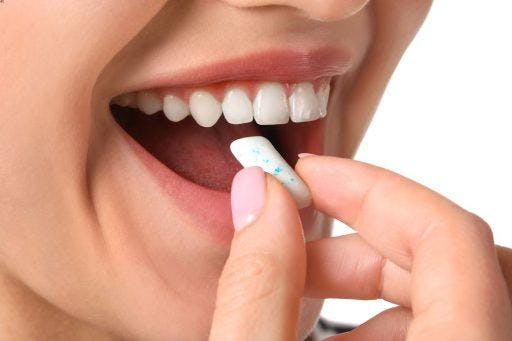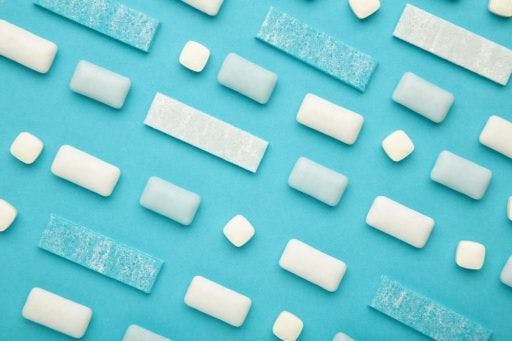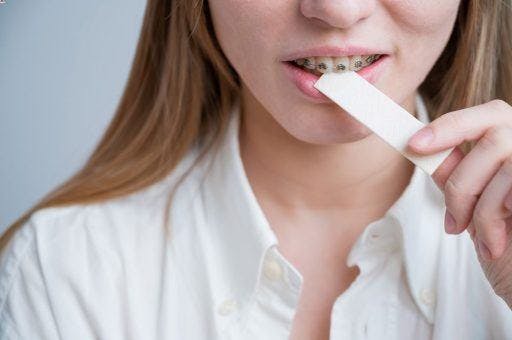You probably know that limiting your sweets intake helps prevent tooth decay and cavities. And since most people would categorise chewing gum under the sugar-coated umbrella of “candy,” you might think you must avoid it, too. But is chewing gum that bad for you? The answer might come as a surprise! Learn more about the ooey-gooey after-meal treat and whether it helps – or hurts – your oral health.
How Chewing Gum Can Help Your Mouth

The American Dental Association (ADA) and the FDI World Dental Federation (FDI) agree that gum offers numerous benefits for your mouth. But what does chewing gum do that makes it worthy of so many experts’ seals of approval? One of its main advantages is promoting salivary flow.
As icky as it sounds, the ADA considers saliva “the bloodstream of the mouth.” That’s right: you need consistent saliva flow to “build and maintain the health of soft and hard tissues.” The less saliva you produce, the greater your risk for tooth decay, bad breath, dental erosion, and other issues. Now those are the real icky situations!
Here’s how it helps: saliva is your mouth’s natural defence against harmful acids that weaken teeth and lead to cavities. It offers antimicrobial compounds that help defend against disease. Saliva also contains digestive enzymes that break down food to keep you from choking. Translation: spit can save your life – and by extension, so can chewing gum.
One review of related literature published in the Frontiers in Oral Health cited numerous clinical trials that support gum-chewing as a preventative measure against dental caries (cavities). The review concluded with a recommendation to chew gum for at least five minutes after meals. Meanwhile, the ADA suggests an upper limit of 20 minutes to reap its benefits.
Pro tip: Go for sugar-free gum.
Get the most out of the habit by chewing sugar-free gum with non-cavity-causing sweeteners. The ADA notes that the sugar alcohol xylitol is particularly effective against plaque and bacterial buildup. Sugar-sweetened gum can still improve saliva flow, but bacteria feed on the sugar to create decay-causing acids. So, if you want “healthy” chewing gum, opt for the sugarless variety.
FAQs About Chewing Gum and Oral Health

Now that you know about the wonders of gum-chewing, you may have a few follow-up questions. Here’s a cheat sheet with some FAQs answered!
1. Can chewing gum replace proper oral hygiene?
No, it can never be a long-term substitute for brushing and flossing. At the most, you can use it as an alternative to brushing after a meal – but brushing will always be better.
In any case, you’ll still need to brush your teeth and floss twice daily for a thorough clean. Gum can’t get in those hard-to-reach areas like dental floss or toothbrush bristles, and it can’t protect or strengthen teeth the way fluoride toothpaste can.
2. Does gum whiten teeth?
Yes, but it’s only a temporary fix. The “whitening” effect of gum is limited to surface (extrinsic) stains. As established, chewing helps with saliva production – and saliva is what neutralises the acidic and staining compounds in your mouth. If you chew gum after drinking a dark liquids like coffee, you might notice that the stains appear less visible than usual.
You can also manage this type of staining by brushing with a whitening toothpaste. However, the only way to change the actual colour of your teeth is by seeing a dental professional for treatment.
3. Can you chew gum while wearing orthodontic appliances?

It’s best to avoid gum-chewing while wearing orthodontics. Gum is very sticky, so it’s likely to get stuck on the brackets and wires of fixed appliances like traditional braces. They’re tricky enough to clean without the added obstacle of gum everywhere.
If you wear removable orthodontics, like ClearCorrect aligners, you can take them off and chew as usual – as long as you still wear them for at least 22 hours daily. Avoid eating, snacking, and chewing in any capacity while wearing clear aligners. You risk compromising the material and, thus, your treatment.
4. Should you carry gum when travelling?
Yes, gum-chewing can help you combat dry mouth in low-humidity environments, such as aeroplane cabins. For those instances, it helps to stay hydrated and chew gum to improve saliva flow. Gum also comes in handy when you have no access to facilities for toothbrushing between meals.
5. Is it okay to chew gum all day, every day?
No, overdoing it can put too much pressure on your temporomandibular joint (TMJ), leading to jaw pain, headaches, and other chronic issues. Chewing on anything excessively can result in TMJ syndrome, a painful condition affecting jaw joints and the surrounding muscles and tissues.
Do you love chewing gum? The surprisingly good news is it can benefit your oral health, especially when you take the proper precautions. Remember to limit gum-chewing to 15-to-20-minute bursts and go for sugar-free options (with xylitol!) that won’t cause cavities. And as tempting as it might be, never use it in place of your daily oral hygiene routine.
References:
American Dental Association. (n.d.). Chewing gum. ADA.org.
American Dental Association. (n.d.). Saliva. Mouth Healthy.
Oral Health Foundation. (n.d.). Sugar free chewing gum. DentalHealth.org.
Vila, T., Rizk, A. M., Sultan, A. S., & Jabra-Rizk, M. A. (2019). The power of saliva: Antimicrobial and beyond. PLOS Pathogens, 15(11), e1008058.
Yeung, C. Y., Chu, C. H., & Yu, O. Y. (2023). A concise review of chewing gum as an anti-cariogenic agent. Frontiers in Oral Health, 4.



